A non-spicy banchan, this Korean soybean sprout side dish is a popular addition to the many varieties of side dishes. Well-seasoned, it is delicious, easy to make and done in 10 minutes!
Jump to:
- Why You’ll Love This Side Dish
- What Is Kongnamul Muchim?
- How Long Does Kongnamul Muchim Last?
- Are Soybean Sprouts the Same as Bean Sprouts?
- Recipe Overview
- Ingredients
- Variations and Substitutions
- Instructions
- Great Mains for This Side Dish
- Frequently Asked Questions
- More Korean Side Dishes Recipes (Banchan 반찬)
- Recipe
Why You’ll Love This Side Dish
This Korean side dish can be made in 10 minutes, is easy to make, and is budget-friendly.
Kongnamul muchim is a popular Korean side dish because it isn’t spicy or pickled, giving the meal some balance. Particularly for kids or those who don’t like too much spicy food.
All it is a quick blanch of the soybean sprouts and then mixed through with some basic and easy to procure ingredients like sesame oil, sesame seeds and garlic. Definitely won’t last very long at the dinner table!
What Is Kongnamul Muchim?
Kongnamul muchim is a popular Korean side dish that is made with soybean sprouts. “Kongnamul” means soybean sprouts, while “muchim” means to season. Thus, this is a seasoned soybean sprout side dish.
The soybean sprouts are crunchy and nutty in flavour while it is well seasoned with garlic, sesame oil, sesame seeds and salt. They are a must have when eating the popular Korean dish, bibimbap.
How Long Does Kongnamul Muchim Last?
Soybean sprouts don’t have an overly long shelf life and can start to lose their freshness in about 2 to 3 days, even when it is cooked. So try and consume it within a few days.
Are Soybean Sprouts the Same as Bean Sprouts?
Bean sprouts are actually the common name for all bean sprouts. There are quite a few different types of bean sprouts, with the most common being the mung bean sprouts.
These are the bean sprouts from mung beans that you’ll find in much Chinese cooking and even salads. Very rarely, however, do we ever call it mung bean sprouts. If the Chinese say bean sprouts, we do automatically mean this variety.
Soybean sprouts are a type of bean sprouts and are therefore different to the mung bean variety. They are sprouted from soybeans and are extremely popular in Korean cuisine. Their yellow heads are crunchier and nuttier and certainly a more vibrant yellow.
Recipe Overview
Flavour/Texture: When cooked al dente, Soybean sprouts are crunchy with a bit of snap. Seasoned with basic ingredients like sesame oil, garlic, salt and pepper, this side dish is unassuming yet delicious.
Ease: Crazy easy. A quick blanch of the soybeans sprouts and tossed through the rest of the ingredients. You really can’t go wrong!
Time: Done in a quick 10 minutes, Kongnamul muchim can also be made in advance so that you can prepare earlier as you plan the rest of your Korean feast!
Ingredients
Ingredients you will need to make Korean Soybean Sprout Side Dish – Kongnamul Muchim.

Soybeans sprouts: Soybeans sprouts can easily be found in Asian grocers in the fresh vegetable section. They usually come in pre-packaged bags, or if really lucky, they will come in a massive tub, and you can purchase them loose to the amount you want.
When selecting soybeans sprouts that are already pre-packed, I always look to see if they have started to go bad as you’ll notice the moisture in the bag has started to get a bit slimy.
Scallion or green onion: Although many Korean banchan call for green onion, I prefer scallions as they have a smaller bulb, making the Korean side dish less pungent. Slice them finely from the tip to the bulb.
Minced garlic: Mince very finely using a garlic press if you have one. It will be the quickest way. Or, if you’re a big garlic fan, you can buy the garlic in a jar.
Sesame oil: Nothing quite beats the aromatic smells of sesame oil. So delicious! Be sure however to get the Korean sesame oil as it does taste different to the Chinese variety.
Sesame seeds: Always best to buy pre-roasted Korean sesame seeds. This way, I don’t have to roast them myself, and it saves me so much time.
Variations and Substitutions
Spicy version: For a spicy version, you can add 1 to 2 tsp of gochugaru (Korean red pepper flakes). Start with 1 tsp and stir it through thoroughly. Add another tsp if it’s not spicy enough for you.
Bean sprouts: If you can’t find soybean sprouts, you can use regular bean sprouts. They are sometimes easier to find in non-Asian supermarkets or grocers.
Type of garlic: You can use fresh garlic or the Korean minced garlic that you can get in a jar. The jar version is great if you’re making a big batch of different types of Korean banchan.
Scallion vs green onion: Either scallion or green onion would work well for this recipe. Look for the smallest possible bulb as it may be too strong to use all of the bulb of the green onion.

Instructions
Step by step instructions for how to make Korean Soybean Sprout Side Dish – Kongnamul Muchim.
Rinse the soybean sprouts and discard any that are limp or have started to brown.
Although not necessary, you can cut off the root end and discard it. Removing the end can be time-consuming, so we opted to show you what it would look like with the roots on for this recipe.
If you’re not fussed either way, and you’re just making it for yourself to eat at home, just leave the roots on. It will save you so much time!
However, if you’re making Kongnamul Muchim for friends and family or if you’re entertaining, it pays to present it better without the soybean sprout roots.
If you have a big batch to make, do it like all the aunties (which includes me!), in a bowl in front of a TV or iPad while watching some Kdrama!
Bring a cup of water and ½ tsp of salt in a small saucepan to the boil. Add the soybean sprouts, cover with a lid and boil for about 3 minutes. Do not open the lid as it will cause the soybean sprout odour to permeate through the water, causing an unpleasant smell.
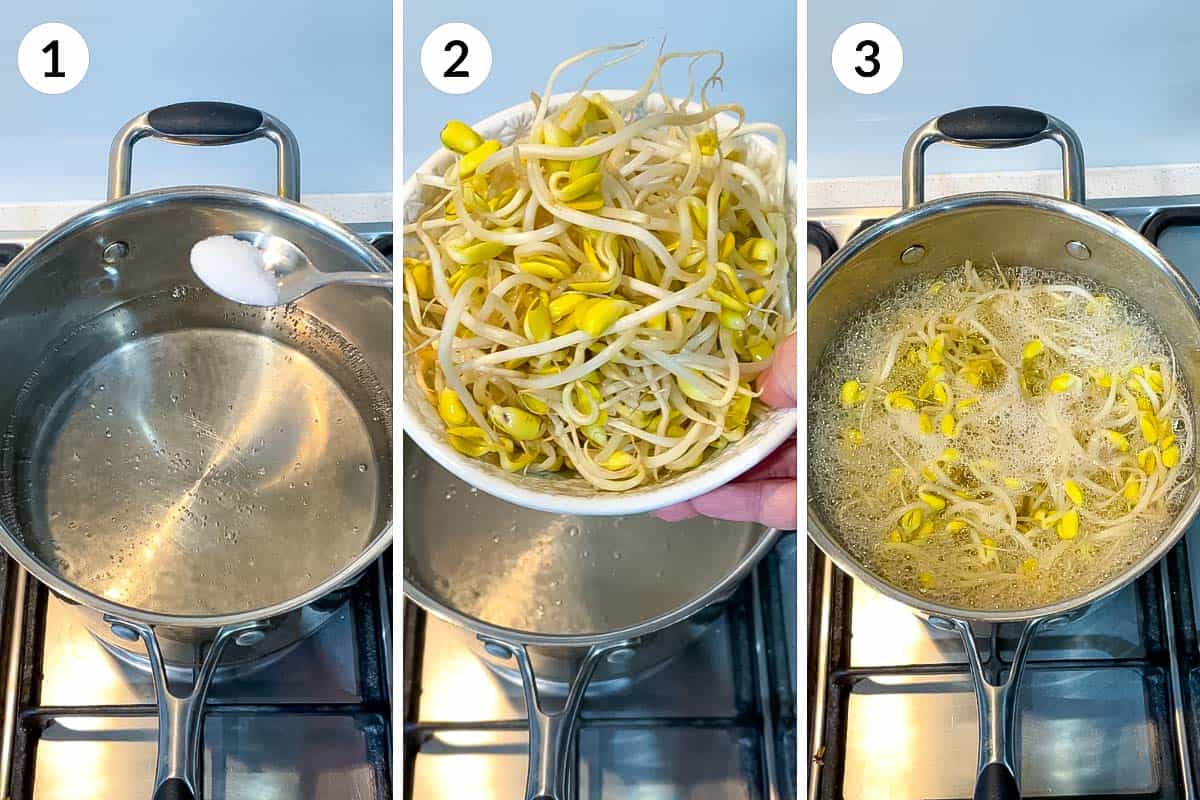
When cooked, place in cold ice-cold water to stop the cooking process and allow the soybean sprouts to maintain their crunch. Place in a prep bowl and pat dry.
Finely chop the whole sprig of scallion or green onion.

If using fresh garlic, mince enough to yield 1 tsp.
Add the scallion, minced garlic, sesame oil, sesame seeds, salt and pepper to the soybean sprouts. Mix until well combined.

Great Mains for This Side Dish
How to serve Korean Soybean Sprout Side Dish – Kongnamul Muchim? Nothing quite beats some Korean favourites such a s Spicy pork bulgogi, Korean fried chicken and traditional sweet potato noodles, Japchae.
Frequently Asked Questions
Yes, you can eat soybean sprouts raw. In fact, they make for a fantastic salad ingredient as you toss it through some salad greens and a homemade salad dressing.
Soybean sprouts are susceptible to spoilage rather quickly, so it is always best used as soon as you can. If you purchase them in a pre-packed format, refrigerate them until used.
You can also remove them from the packet, submerge them in cold water and place them in the fridge. This will keep them fresher for a couple of days.
If you have leftover soybean sprouts, you can make a simple stir fry with garlic and have it for another meal or pack for lunch. Alternatively, you can eat them raw in a salad too.
How easy is it to Kongnamul muchim? I also love the fact that it’s so budget friendly and made with some easy pantry staples. Enjoy this Korean soybean sprout side dish! We love it!
That’s all!
More Korean Side Dishes Recipes (Banchan 반찬)

Follow us on Facebook, Pinterest, Instagram and Twitter for the latest updates!
Recipe
Korean Soybean Sprout Side Dish – Kongnamul Muchim (콩나물 무침)
Ingredients
- 500 g soybean sprouts
- 1 cup water
- 1 tsp salt, divided
- 1 sprig scallion, (spring onion)
- 1 tsp garlic, minced
- 1½ tsp sesame oil
- 1 tsp white sesame seeds
- 1 pinch pepper
Click on the toggle below for conversion to US Cooking Units.
Instructions
- Rinse the soybean sprouts and discard any that are limp or have started to brown. Although not necessary, you can cut off the root end and discard it.
- Bring a cup of water and ½ tsp of salt in a small saucepan to the boil. Add the soybean sprouts, cover with a lid and boil for about 3 minutes. Do not open the lid as it will cause the soybean sprout odour to permeate through the water, causing an unpleasant smell.
- When cooked, place in cold ice-cold water to stop the cooking process and allow the soybean sprouts to maintain their crunch. Place in a prep bowl and pat dry.
- Finely chop the whole sprig of scallion (spring onion) or green onion.
- If using fresh garlic, mince enough to yield 1 tsp.
- Add the scallion (spring onion), minced garlic, sesame oil, sesame seeds, salt and pepper to the soybean sprouts. Mix until well combined.
Notes
- For a spicy version, you can add 1 to 2 tsp of gochugaru (Korean red pepper flakes).
- If you can’t find soybean sprouts, you can use regular mung bean sprouts. They are sometimes easier to find in non-Asian grocers.
- Cutting the root end or the tail of the soybean sprout is only a matter of choice and presentation. They are edible, but some people really do dislike them.
- It is important to leave the lid of the saucepan closed when cooking the soybean sprouts—lifting it while it is cooking causes the raw soybean sprout smell to linger, and it becomes hard to get rid of it.
- You can use fresh garlic or the Korean minced garlic that you can get in a jar. The jar version is great if you’re making a big batch of different types of Korean banchan.
- Either scallion or green onion would work well for this recipe. Look for the smallest possible bulb as it may be too strong to use all of the bulb of the green onion.
Nutrition
*Disclaimer: Nutritional information provided is an estimate only and generated by an online calculator.
Don’t want to miss out on a recipe? Feed your FOMO and we’ll deliver it into your inbox!
Disclaimer: This site contains affiliate links to products. We may receive a commission for purchases made through these links at no additional cost to you.


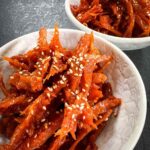
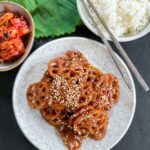

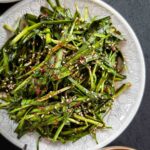









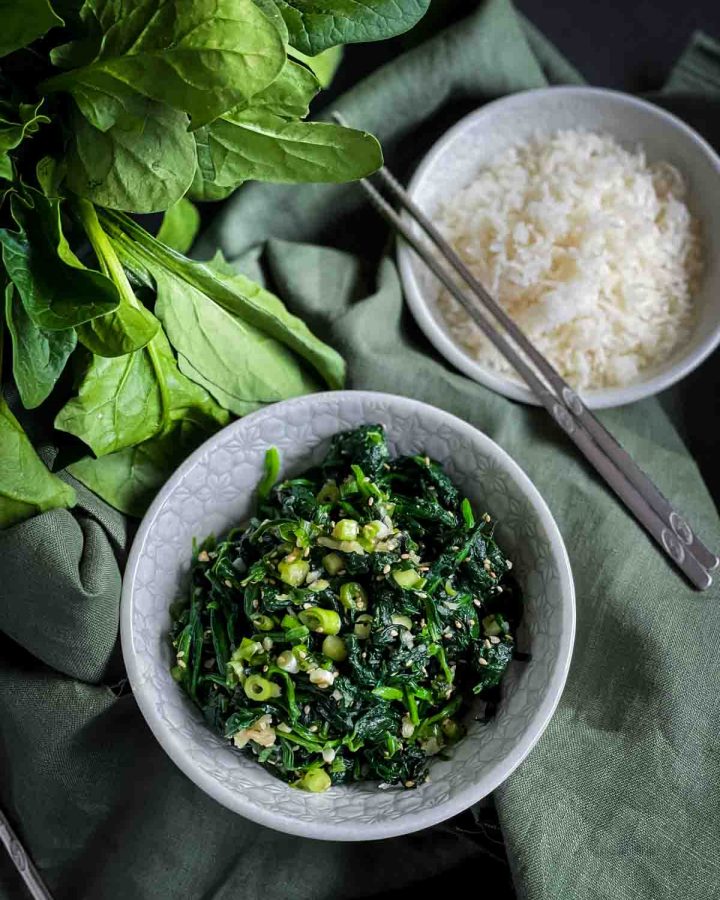
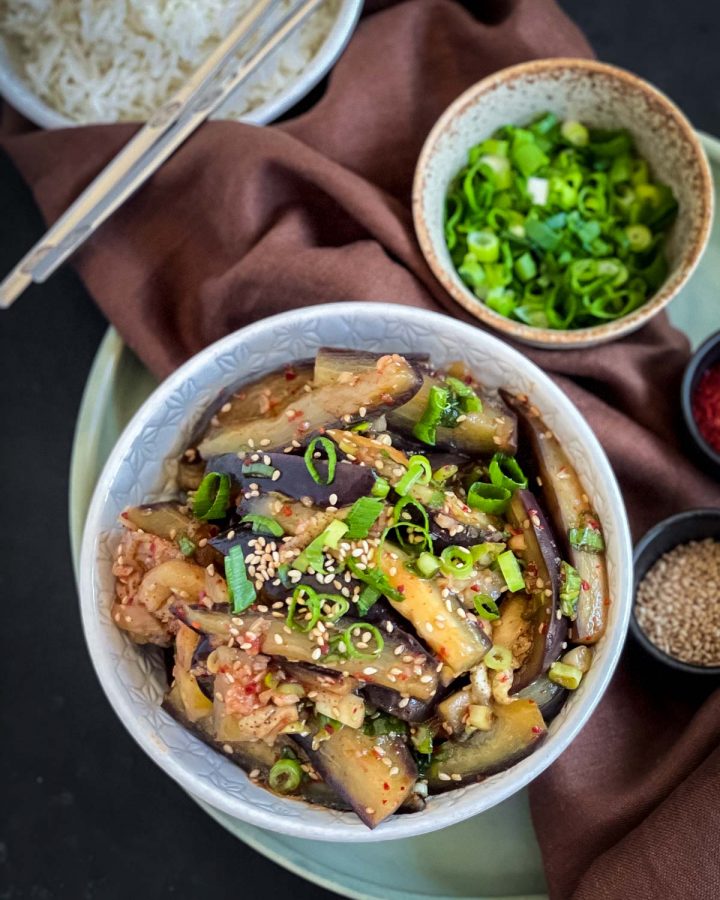
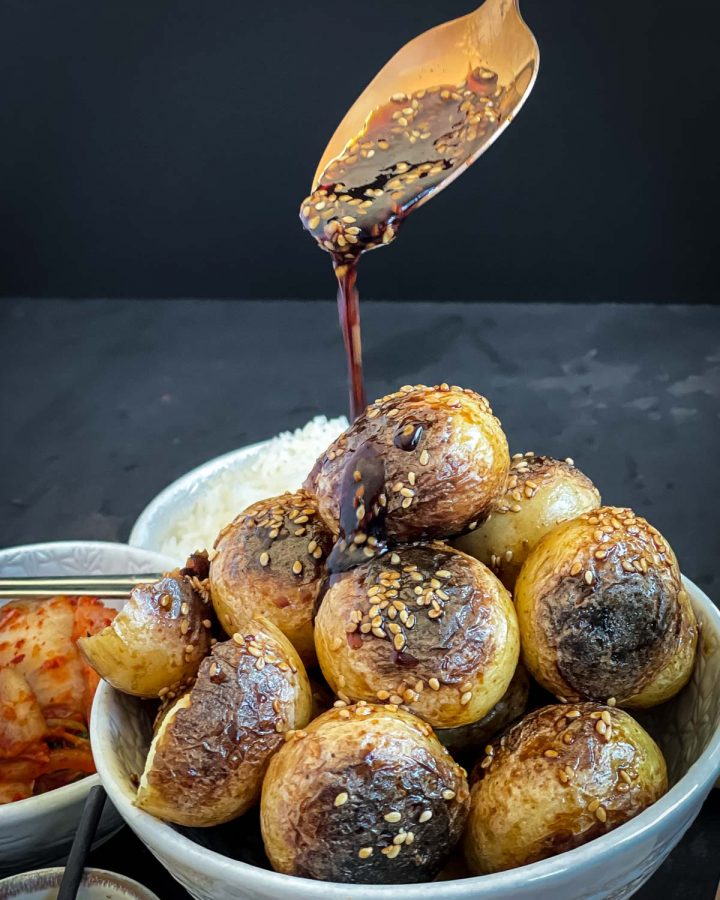
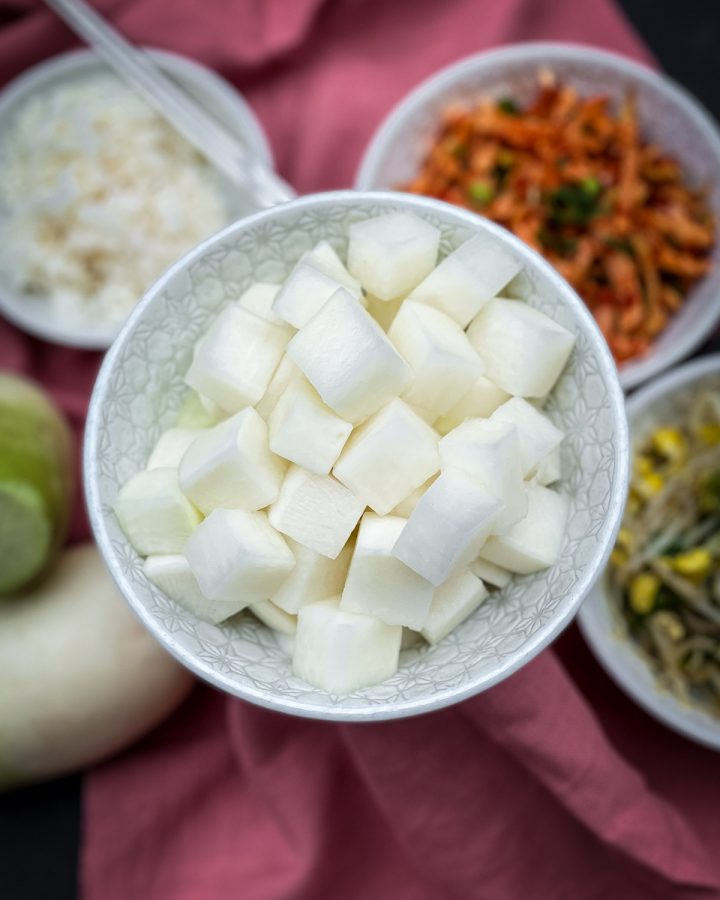

KT
Dang! This is delicious! Thank you for sharing. I like salads that aren’t lettuce based.